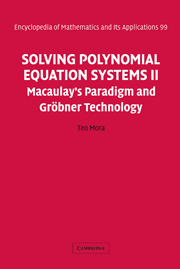35 - Gianni–Trager–Zacharias
from Part five - Beyond Dimension Zero
Published online by Cambridge University Press: 05 June 2013
Summary
The Primbasissätze presented in the previous chapter give the tools needed in order to devise algorithms for computing Lasker–Noether decompositions and related concepts.
In Section 35.1 I introduce the computational problems related to Lasker–Noether decomposition which will be discussed throughout the chapter.
Section 35.2 presents the Gianni–Trager–Zacharias solution (mainly a direct application of the Primbasissätze) for a zero-dimensional ideal.
Section 35.3 contains the result (Theorem 35.3.4) allowing us to reduce the general case to the zero-dimensional one, and presents both their approach (GTZ-scheme) and a suggested improvement (ARGH-scheme): the GTZ-scheme has the disadvantage that the algorithms produce many redundant spurious components which must be tested and removed; the ARGH-scheme avoids such production of spurious components but at the price of also removing embedded components which must be recovered later.
Section 35.4 gives the solution, by means of the GTZ- and ARGH-schemes, of the decomposition problems.
If the ideal to be decomposed is in allgemeine position, the best shape of the bases allows us to strongly improve the algorithms (Section 35.5); however, the price of being in allgemeine position is full-density of all the data; this requires techniques allowing the computation of an allgemeine coordinate preserving sparsity as much as possible (Section 35.6); in connection with this problem, there have also been proposals to apply Möller's algorithm (Section 35.7) in order to avoid density when performing the ARGH-scheme.
- Type
- Chapter
- Information
- Solving Polynomial Equation Systems IIMacaulay's Paradigm and Gröbner Technology, pp. 614 - 664Publisher: Cambridge University PressPrint publication year: 2005

